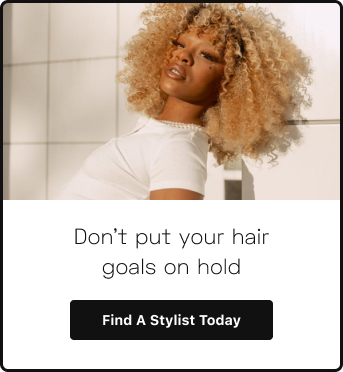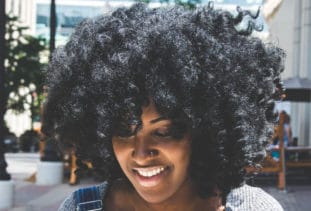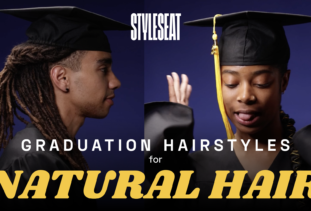Whether you’ve recently made the switch or you’ve been rocking your curls for years, finding the best hair products for natural hair isn’t always easy. Furthermore, even an established hair care routine can often use a boost — especially if you’ve noticed any new changes in your hair.
Of course, every product is going to provide different results. In order to give your curls the love they need, it’s important to understand what different treatments can do for natural hair. From moisturizing strands to clarifying the scalp — and everything in between — read on to learn more about choosing the best natural hair treatment.
Understand Your Hair’s Needs
When searching for a natural hair treatment, the first step is to look inward. Or, more appropriately, upward (at your hair). Basically, you’ll want to determine exactly what it is that your hair needs right now.
Natural hair requires maintenance in several different categories. If your locks have been feeling a little lackluster lately, it’s crucial to figure out where the problem lies. Possibilities may include:
- Lack of moisture or hydration (two very different things)
- Build up of product on strands or scalp
- Scalp irritation
- Breakage, tangles, and split ends
- Loss of curl pattern/volume
With so many possibilities, finding the culprit of your curl problems can be tricky. Fortunately, we’ve got you covered. Below are some of the most common signs of each natural hair issue, along with the type of treatment you’ll need to fix it.
The Problem: Lack of Moisturization or Hydration
First and foremost, let’s talk about moisture and hydration. While these two terms may sound like synonyms, they actually perform two very different jobs in the world of natural hair care. Let’s take a look at how moisture and hydration compare and how to tell if your curls require one or the other:
- Hydration – Hydration is the frontline of keeping hair soft, strong, and bouncy (rather than frizzy and weak). When you hydrate the hair, you’re really focusing on penetrating each strand and allowing the hair follicles to absorb water. Hydration is all about moisture absorption.
- Moisturization – Now moisture, on the other hand, is all about moisture retention. This refers to the hair’s ability to lock water in and maintain softness for an extended period. If you find your hair gets brittle between washes, this signifies a problem with moisturization, not hydration.
The solution – While hydration can be achieved with water-based products, such as shampoos and deep conditioners, an oil-based treatment will best moisturize the hair. Some of the best oils and butters for dry curls include shea butter, almond oil, castor oil, and jojoba oil. The last three examples can be used for hot oil treatment. Another surprising ingredient to restore hair moisture is coconut milk. You may also opt for a pre-shampoo oil rinse to help strands better absorb moisture, especially if you have curly hair. Common oils for a pre-rinse include apricot oil, avocado oil, and coconut oil.
The Problem: Product Build Up
Yes, maintaining natural curls requires some products — but using too much of these products can also become a problem in itself.
Here’s the thing about products: they can lead to heavy, waxy build-up on both the scalp and the individual hair strands. Not only that, but natural oil production can also lead to build-up on the scalp. Furthermore, a combination of both product and natural build-up is basically a recipe for limp curls and itchy scalp.
How can you spot scalp and strand build-up? Just look for the telltale signs:
- Your hair lacks shine
- You have a dull, white cast on your strands or scalp
- You have white flakes on your scalp
- Your hair feels dry, but your scalp feels oily
- Your hair feels rough or stiff
- Your curls feel heavier than usual
- You can physically scrape a waxy residue off your hair
The solution – The best treatment for product build-up is clarifying shampoos and conditioners. Regular shampoos — and especially regular conditioners — can contribute to additional build-up, but clarifying shampoos and conditioners will effectively strip your hair of any and all products. Of course, this means that clarifying shampoos can also be pretty drying on the hair, so look for products that also contain botanicals like aloe vera or rosemary leaf for added moisture. Wondering, how often to wash natural hair using a clarifying shampoo and conditioner? Clarifying treatments should only be done once per week at most.
The Problem: Scalp Irritation
Scalp irritation can be caused by a number of different factors, especially for individuals with natural hair. This means that the best treatment for scalp irritation will also depend on its root cause, which may be any of the following:
- Hairstyles – Sometimes, certain hairstyles can actually be the culprit of an itchy, painful, or irritated scalp. This is especially common with some of the most popular Black braided hairstyles that pull on the roots, such as box braids, tight ponytails, or extensions.
- The solution – If you’re committed to your new style, it may take some time for your hair to adjust. After a week or two, pain and irritation from styles like box braids and extensions will subside. In the meantime, you can massage your scalp gently with a warm washcloth or apply a calming treatment like tea tree oil to your roots.
- Dry scalp – Dryness is another common cause of scalp irritation, particularly if you’re experiencing itchiness. This may result from too much shampooing, changes in the weather, or an improper hair care routine.
- The solution – No matter what’s causing your dry scalp, the trick to beating this irritation is by using the right products. Opt for a gentle, sulfate-free shampoo, and apply generous amounts of scalp oil when needed.
- Dandruff – Unlike a dry scalp, dandruff is actually caused by a microbe on the scalp known as Malassezia globosa. For this reason, treating dandruff will require a more unique approach.
- The solution – Use a moisturizing, medicated shampoo to treat dandruff at the source. For severe cases of dandruff, a dermatologist may prescribe a ketoconazole shampoo to be used two or three times per week.
The Problem: Breakage, Tangles, and Split Ends
When taking care of natural hair, it’s important to keep your strands strong and healthy. This means avoiding habits that can damage hair follicles and using the right products and treatments to keep breakage and split ends at bay. Here’s what you should know about treating tangled, brittle hair:
- Breakage – Breakage can be attributed to weak, brittle hair strands. While we may be more familiar with split ends, breakage can actually occur at any point in the hair strand — and the higher it is, the worse the damage will be. Breakage can be exacerbated by over-styling. So if you regularly style your hair in knotless braid styles (or other types of braids for Black hair), not properly maintaining your braids can cause breakage.
- The solution – For weak, damaged hair, a protein treatment will be your best friend, which is more potent than a regular hair conditioner. This is because hair comprises 70 percent keratin protein, and a proper protein treatment can help rebuild these vital structures within each hair follicle. Use a high-quality protein treatment and only apply it as needed because too much protein can also lead to brittle hair. You might be tempted to use a DIY protein treatment, but the risk is it might not be formulated correctly. So stick with whatever your stylist or trichologist recommends.
- Tangles – Tangles are another culprit of breakage, especially when handled poorly. Ripping through tangles and tight curls is essentially a recipe for disaster. You’ll want to make sure you’re working through tangles gently and trying your best to avoid them at all costs, even more so if you already have dry hair.
- The solution – A good detangler or leave-in conditioner will help ease the pain of knots and help you comb through hair more easily. Using one or both of these treatments will ultimately prevent breakage caused by tangles and rough combing.
- Split ends – Finally, we have the most common form of hair breakage: split ends. Everyone gets split ends, but the way you treat them will determine how healthy your hair is.
- The solution – One of the most beneficial natural hair care tips is to trim your hair regularly to stop split ends from getting worse. While oils and conditioners may reduce the dry appearance of split ends, the only way to truly rid yourself of them is by cutting the hair. Also, trimming actually promotes natural hair growth because it gets rid of the damaged ends. You can also help prevent split ends by moisturizing them daily and staying away from heated styling tools.
The Problem: Loss of Curl Pattern and Volume
Finally, we have one of the most frustrating problems you can face as a natural-haired beauty: loss of curl pattern.
Unfortunately, sometimes curly hair loses its normal texture and volume. This can be the result of several factors, including:
- Heat damage
- Heavy products, especially those with silicones and sulfates
- Chemical damage from relaxers or hair dye
- Environmental factors, such as hard water, humidity, or UV damage
The solution – Try opting for a restorative hair mask when your curls need an extra pick-me-up. These masks will typically contain rich, fatty ingredients like castor oil or shea butter. Your curls will have a better chance of soaking up moisture and getting their bounciness back by using a mask. Using a water filter in the shower and wearing a hat in the sun can also help diminish environmental damage to the hair.
Is it safe to DIY?
One of the reasons people try to treat their hair problems themselves is because they can use ingredients they can find at home, such as lemon juice, olive oil, apple cider vinegar, baking soda, egg yolk, etc. If you have considered the DIY approach, keep in mind that you are not an expert, and any concoction you make might further damage your hair.
Take Care of Your Hair with StyleSeat
Figuring out which hair product you need can be difficult on your own, and actually applying all these treatments can be an even more intimidating task. Whether you are searching for the best natural hair stylists in San Diego or Atlanta, look no further than StyleSeat to get connected to local industry experts.
Fortunately, StyleSeat has you covered. With our online booking app, StyleSeat makes it easy to search for qualified stylists, hair salons, facialists, nail technicians, and more. With plenty of small businesses available through the app, you’ll quickly find your go-to spots with highly qualified beauty professionals. Give your curls the love they deserve and find the perfect natural hair treatment with StyleSeat!
Sources:
NaturallClub. Hairy Hydration vs. Hairy Moisturization. https://naturallclub.com/blogs/the-naturall-club-blog/hydration-vs-moisturization
CurlCentric. Ultimate Guide to Finding the Best Natural Hair Products for Your Regimen. https://www.curlcentric.com/natural-hair-products/
Salon Worthy Hair. How to Tell if You Have Product Buildup in Your Hair – Signs and Symptoms to Watch Out For. https://salonworthyhair.com/shampoos/clarifying/product-buildup-signs-symptoms/
AfroCenchix. Product Buildup: A Tricky Afro Hair Care Problem. https://afrocenchix.com/blogs/afrohair/product-buildup-the-tricky-afro-hair-care-problem
Head and Shoulders. How to Stop Itch with Natural Hair. https://headandshoulders.com/en-us/healthy-hair-and-scalp/hair-care/how-to-stop-itch-with-natural-hair
Byrdie. What Can I Do About Braids That Are Too Tight? https://www.byrdie.com/braids-that-are-too-tight-5079461
Naturally Curly. What to do When our Hair Loses its Curl. https://www.naturallycurly.com/curlreading/how-tos-styles/what-to-do-when-hair-loses-its-curl





